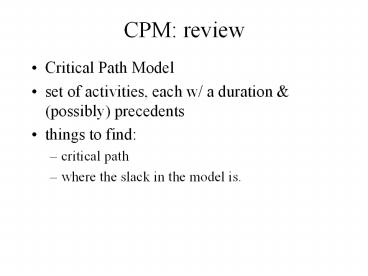CPM: review - PowerPoint PPT Presentation
1 / 5
Title: CPM: review
1
CPM review
- Critical Path Model
- set of activities, each w/ a duration
(possibly) precedents - things to find
- critical path
- where the slack in the model is.
2
Using Excel to analyze CPM
Use Excel to set up this problem and find the
critical path.
3
Using Excel to analyze CPM
Focus on the nodes to find the critical path and
overall project time. Using nodes, build matrix
of activities w/ -1, 0, 1 to describe
activities List durations create formulas to
relate the nodes to the activities sumproduct(c
13,c6) which describes the earliest time and
the latest time that an activity could
start/finish, hence the total time available to
that activity. Let the last node project time
(or length of the critical path) in Solver,
target cell project time changing cells
nodes constraints calc. Available time gt
duration
4
Defining slack, es, ef, ls, lf
- Slack how much extra time you have available for
a particular activity. - ES -- early start the earliest possible time
you could begin a particular activity. - EF -- early finish the earliest possible time
you could finish a particular activity. - LS -- late start the latest possible time you
could begin a particular activity. - LF -- late finish the latest possible time you
could finish a particular activity.
5
Calculating slack, es, ef, ls, lf
- Slack (time available) - (duration)
- ES (calc. time at the beginning node)
- EF ES duration
- LS LF - duration
- LF (calc. time at the ending node)































